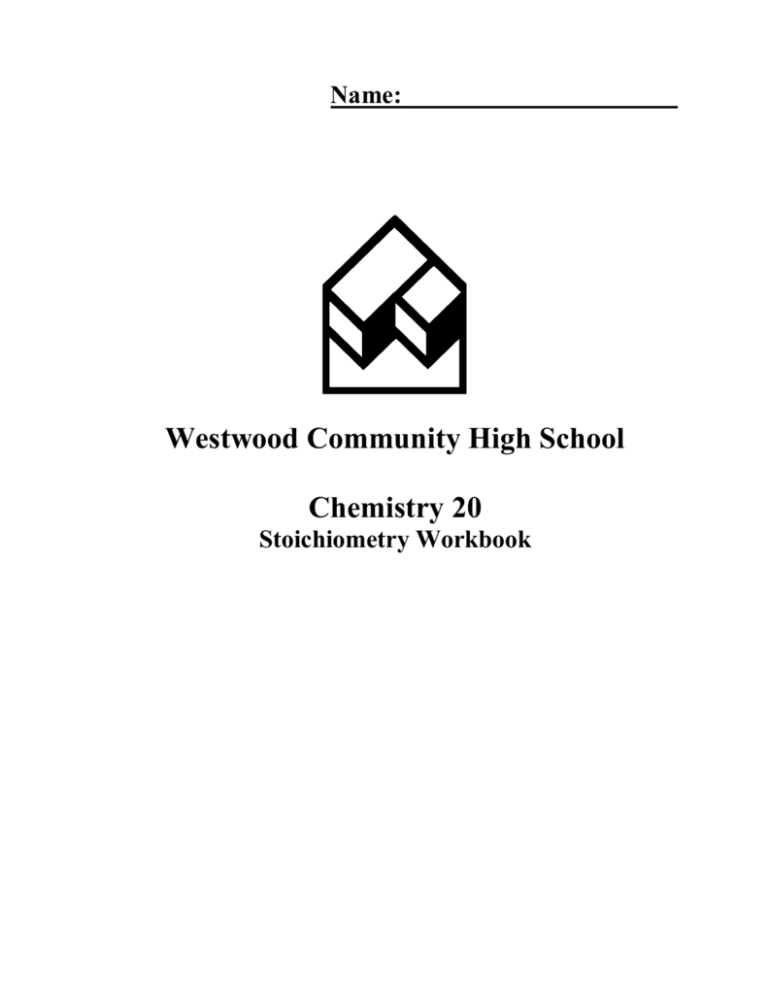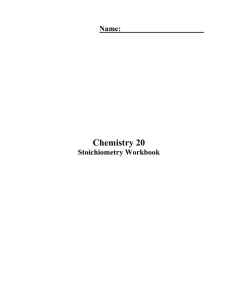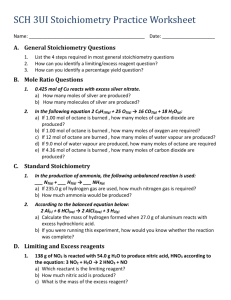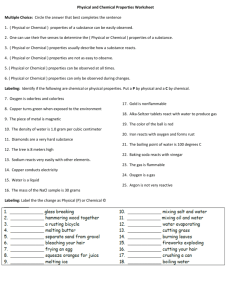wokbook stoichiometry
advertisement

Name:______________________ Westwood Community High School Chemistry 20 Stoichiometry Workbook Review of Chemical Reactions Write the balanced equations, including states, for the following chemical reactions. Give the reaction type for each reaction. 1. Cyclopentane, C5H10(ℓ), reacts with oxygen to produce carbon dioxide and water vapour. 2. Copper(I) oxide forms from its elements. 3. Phosphoric acid is neutralized by cesium hydroxide solution to produce cesium phosphate solution and liquid water. 4. Ethanol breaks up into its elements. 5. Lead(II) acetate reacts with zinc metal to form zinc acetate solution and solid lead. 6. Chromium(III) oxide decomposes into its elements. 7. Calcium chlorate solution reacts with lithium sulfate and calcium sulfate solid forms in a lithium chlorate solution. 8. Dinitrogen tetraoxide gas forms from its elements. 9. Octane (C8H18(ℓ)) reacts with oxygen gas to produce carbon dioxide and liquid water in a bomb calorimeter. Chem 20 Stoichiometry Workbook 1 Jill Agnew 10. Aluminium nitrate solution reacts with magnesium metal to produce magnesium nitrate solution and aluminium metal. 11. Nitrogen triiodide decomposes explosively into its elements. 12. Solutions of calcium nitrate and potassium phosphate are mixed. 13. The main fuel used to propel rockets into outer space is liquid hydrogen combining with liquid oxygen to produce water vapour. 14. Steel wool (iron) will burn with a blinding flash in pure oxygen. The iron (III) compound is formed. 15. In the Haber process, nitrogen and hydrogen gas are reacted under high pressure and temperature conditions to produce ammonia gas. 16. Iron reacts with silver nitrate. The iron (III) compound is formed. 17. Phosphorus burns in air to produce solid diphosphorus pentaoxide. 18. Propane (C3H8(g)) undergoes complete combustion. 19. Sulphur burns in air to produce sulphur dioxide gas. 20. Chlorine gas is bubbled through an aluminum iodide solution. Chem 20 Stoichiometry Workbook 2 Jill Agnew Mole to Mole Calculations 1. How many moles of gas is produced when 15.3 moles of calcium chloride decomposes? 2. How many moles of hydrogen are needed to react with 19.66 mol of oxygen. 3. If 5.50 moles of zinc chloride reacts with ammonium sulfide, how many moles of precipitate are formed? 4. Calcium oxide and diphosphorus pentoxide react to produce calcium phosphate. How many moles of calcium phosphate will be produced if 18.2 moles of calcium oxide are used? 5. How many moles of gas are formed if 9.67 moles of aluminum chloride decomposes? Chem 20 Stoichiometry Workbook 3 Jill Agnew Gravimetric Stoichiometry Calculations 1. Iron reacts with chlorine as follows: 2Fe(s)+ 3Cl2(g) → 2FeCl3(s) How many grams of iron(III) chloride would form if 0.520 g of chlorine reacted? 2. Ethane (C2H6(g)) reacts with oxygen in a hydrocarbon combustion reaction. How many grams of ethane need to burn to cause 10.6 g of water vapour to form? 3. Xenon can be made to react with fluorine gas at about 400 oC. The product that forms is xenon tetrafluoride(g). How many grams of xenon tetrafluoride will form if 4.35 g of fluorine react? Chem 20 Stoichiometry Workbook 4 Jill Agnew 4. Calculate the mass of iron (III) oxide (rust) produced by the reaction of 250 g of iron with oxygen from the air. 5. What mass of precipitate should form when 5.00 g of silver nitrate solution is reacted with excess sodium chloride solution? 6. Determine the mass of water vapour formed when 1.00 g of butane, C4H10(g), is burned in a lighter. Chem 20 Stoichiometry Workbook 5 Jill Agnew Solution Stoichiometry Calculations 1. What volume of 0.125 mol/L NaOH(aq) is required to react completely with 15.0 mL of 0.100 mol/L Al2(SO4)3(aq)? 2. In a chemical analysis, a 10.0 mL sample of H3PO4(aq) was reacted with 18.2 mL of 0.259 mol/L NaOH(aq). Calculate the concentration of the phosphoric acid. 3. Silver nitrate and sodium chromate solutions react as follows: 2AgNO3(aq) + Na2CrO4(aq) → Ag2CrO4(s) + 2NaNO3(aq) How many grams of precipitate will form if 200 mL of 0.500 mol/L silver nitrate react with sodium chromate? Chem 20 Stoichiometry Workbook 6 Jill Agnew 4. What volume of 0.320 mol/L sulfuric acid reacts with 47.3 mL of 0.224 mol/L sodium hydroxide? 5. A student adds 5.77 g of zinc to 100 mL of HCl(aq) . What would the concentration of zinc chloride be in the 100 mL solution when all the zinc had reacted? 6. The concentration of magnesium ions from magnesium chloride in sea water was analyzed and found to be 50.0 mmol/L. What volume of 0.200 mol/L sodium hydroxide solution would be needed in an industrial process to precipitate all of the magnesium ions from 1.00 ML of sea water? Chem 20 Stoichiometry Workbook 7 Jill Agnew Law of Combining Volumes Calculations Solve these questions assuming that the conditions of temperature and pressure of both reactants and products are the same. 1. Write the reaction for the formation of water vapour from hydrogen and oxygen gas. (a) How many moles of hydrogen react with 3.4 mol of oxygen gas? (b) How many litres of water vapour would form if 9.4 L of oxygen react? 2. Write the balanced equation for the combustion of propane (C3H8(g)). (c) How many litres of propane must react in order to make 2.36 L of water vapour? (d) How many moles of oxygen must react to produce 35.8 mol of carbon dioxide? (e) The total volume of products that form if 9.53 L of propane reacted with oxygen would be _____________L. 3. Write the reaction between sulfur and oxygen to produce sulfur trioxide gas. (a) How many litres of sulfur trioxide would form from the reaction of 0.65 L of oxygen? (b) How many moles of oxygen need to react to form 1.56 mol of sulfur trioxide? Chem 20 Stoichiometry Workbook 8 Jill Agnew Gas Stoichiometry Calculations 1. The first recorded observation of hydrogen gas was made by the famous alchemist Paraclesus when he added iron to sulphuric acid. Calculate the volume of hydrogen gas at 20C and 98 kPa produced by added 10 g of iron to excess sulphuric acid. 2. What mass of sulphur must be burned in the presence of oxygen to produce 112 L of sulphur dioxide at STP? 3. How many grams of sodium metal will form as 10.5 L of nitrogen form at 25.0 oC and 132.0 kPa? The production of a gas to fill an airbag rapidly is accomplished by the following reaction: 2NaN3(s) → 2Na(s) + 3N2(g) Chem 20 Stoichiometry Workbook 9 Jill Agnew 4. Carbon dioxide gas can be removed from the air by bubbling it through LiOH(aq) solution. How many grams of lithium carbonate would form if 25.0 L of CO2(g) were absorbed at 28.3 oC and 95.0 kPa? The reaction is as follows: 2LiOH(aq) + CO2(g) → Li2CO3(aq) + H2O(ℓ) 5. A piece of zinc is dropped into a large volume of nitric acid, and 37.0 L of hydrogen gas form as a result. If the hydrogen was collected at 20.0 oC and 85.0 kPa, what mass of zinc reacted? 6. Coal, pure carbon, can undergo incomplete combustion in the absence of a plentiful supply of air to produce deadly carbon monoxide gas. What volume of carbon monoxide is produced at SATP by the incomplete combustion of 150 kg of coal? Chem 20 Stoichiometry Workbook 10 Jill Agnew Limited and Excess Reagents 1. 1.24 g of manganese(II) iodide reacts with 25.0 g of fluorine gas. What mass of manganese(III) fluoride is expected? Manganese(III) fluoride is formed in the following reaction: 2MnI2(s) + 13F2(g) → 2MnF3(s) + 4IF5(ℓ) 2. A quantity of sodium sulphide with a mass of 8.76 g is added to 350 mL of 0.250 mol/L lead(II) nitrate solution. Which reactant is limiting and what mass of precipitate is formed? 3. A 25.0 mL volume of 0.400 mol/L lead(II) nitrate is mixed with 300 mL of 0.220 mol/L potassium iodide. What is the maximum mass of precipitate that can form? Chem 20 Stoichiometry Workbook 11 Jill Agnew 4. What mass of liquid water is expected when 2.00 L of hydrogen gas reacts with 2.00 L of oxygen gas, both at 22 oC and 102.5 kPa? 5. When ammonia gas reacts with oxygen gas, the products are nitrogen dioxide gas and water vapour. A 1.30 kg mass of ammonia is present in 4.21 kg of oxygen gas. What mass of nitrogen dioxide is expected? 6. What mass of NO(g) is produced when 57.4 g of Cu reacts with 165 g of HNO3? Copper metal reacts with nitric acid according to the following reaction: 3Cu(s) + 8HNO3(aq) → 3Cu(NO3)2(aq) + 2NO(g) + 4H2O(ℓ) Chem 20 Stoichiometry Workbook 12 Jill Agnew Predicted and Experimental Yield 1. When 7.5 × 101 g of nitrogen gas reacts with sufficient hydrogen gas, the theoretical yield of ammonia is 9.10g. If 1.72 g of ammonia is obtained by experiment, what is the percentage yield of the reaction? 2. 20.0 g of bromic acid, HBrO3, is reacted with excess HBr. HBrO3(aq) + 5HBr(aq) → 3H2O(ℓ) + 3Br2(aq) a. What is the predicted yield of Br2 for this reaction? b. If 47.3 g of Br2 is produced, what is the percentage yield of Br2? 3. In order to produce a lead(II) chromate precipitate, lead(II) chloride reacts with sodium chromate in solution. A 12.5 g mass of lead(II) chloride is mixed into solution, and is allowed to react with excess sodium chromate. a. What is the predicted yield of lead(II) chromate? b. Calculate the percentage yield if 13.8 g of lead(II) chromate is produced experimentally. 4. When calcium carbonate reacts with hydrogen chloride, the products are calcium chloride, carbon dioxide and water. If this reaction occurs with 81.5% yield, what mass of carbon dioxide will be collected if 15.7 g of calcium carbonate is added to sufficient hydrogen chloride? Chem 20 Stoichiometry Workbook 13 Jill Agnew Titrations 1. A student conducts three trials to determine the concentration of barium hydroxide. The titrant used is a 0.250 mol/L hydrochloric acid solution. Each sample of barium hydroxide is 10.00 mL. Calculate the concentration of the barium hydroxide. Trial # 1 2 3 Final volume HCl(aq) (mL) 24.56 37.32 50.00 Initial volume HCl(aq) (mL) 11.78 24.56 37.32 Volume of HCl(aq) (mL) 2. A solution contains an unknown concentration of H3PO4(aq). You take 10.0 mL of this acid and titrate it with a 0.750 mol/L solution of NaOH(aq). Calculate the concentration of the phosphoric acid using the following data. Trial # 1 2 3 4 5 6 Final volume NaOH(aq) (mL) 16.05 29.92 44.01 14.93 28.64 42.33 Initial volume NaOH(aq) (mL) 0.00 16.05 29.92 0.72 14.93 28.64 Volume of NaOH(aq) (mL) Chem 20 Stoichiometry Workbook 14 Jill Agnew




